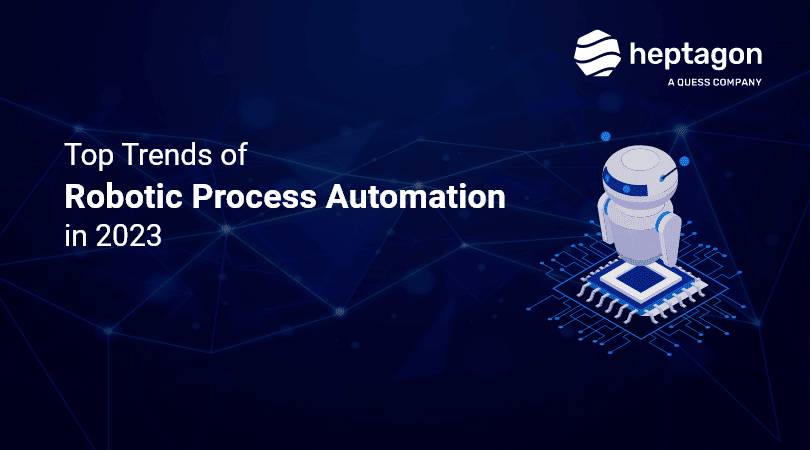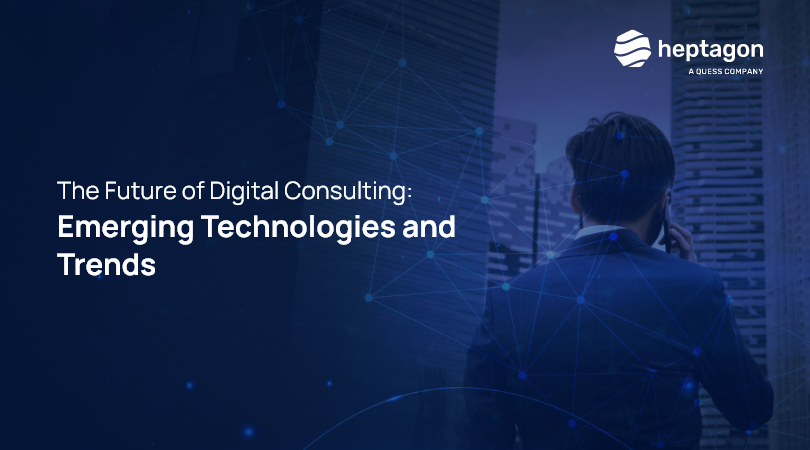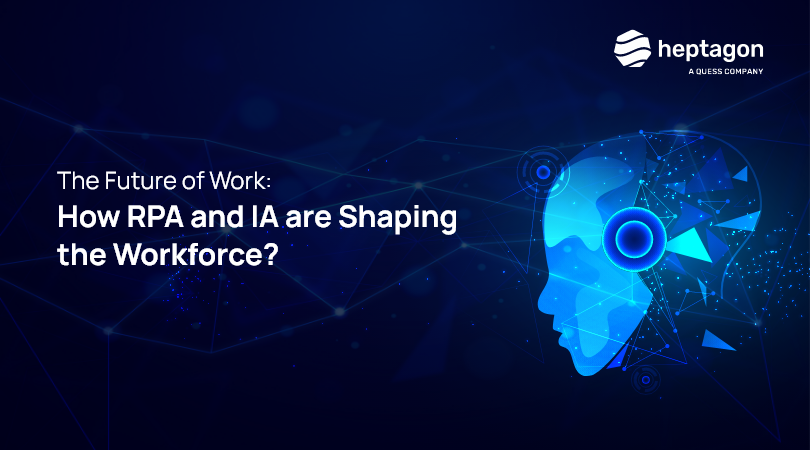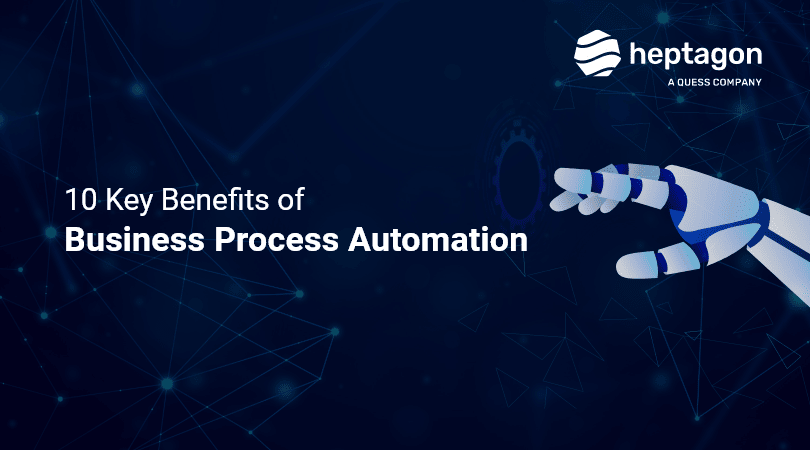Robotic Process Automation (RPA) has proven to be an impactful technology that has been a catalyst for digital transformation. Businesses across industries have kickstarted their RPA implementation journey. RPA greatly benefitted the banking and manufacturing industries through the pandemic and is expected to leave a lasting impression on how routine, repetitive tasks are carried out. And what this means with regard to availability of time, decreased cost, and access to creative human caliber.
This article highlights the top ten RPA trends of 2023 and they are:
1. An increase in the adoption of Managed RPA Services
The technical complexity of RPA makes it difficult to adopt for businesses. But with competitive pricing given the increase in Managed RPA Services, businesses will resort to implement RPA bots for numerous reasons. Earlier, organizations faced issues in implementing RPA as the costs involved in deployment, resources planning, and infrastructure were significant. A managed service provider allows the business to outsource its automation and in 2023 more companies would resort to this option.
2. RPA integration with different technologies
In principle, RPA is a rule-based solution that focuses on automating repetitive tasks. This could include, but not limited to reporting, invoicing and data entry. These back-office tasks and their subsequent automation is why RPA has gained popularity. But, with a growing demand for better customer-facing service, the number of tasks that the front office deals with has risen. This opens a new possibility where RPA can take charge of end-to-end automation tasks. For instance, an RPA bot integrated with a customer service chatbot helps in the direct extraction of customer data with little to no human intervention. Further, RPA bots can also handle employee requests such as initiating workflows and data collection.
3. Greater demand for RPAaaS
RPA as a Service (RPAaaS) has secured its place in the emerging trends for 2023 given its increase in popularity in the last few years. During the pandemic, many organizations implemented this model and were successful in surviving historically uncertain times. The future of RPA will be greatly beneficial to the healthcare and banking industries as they have been able to weather the pandemic given the help of this technology. This continues to be a viable option due to minimal costs and efforts incurred in receiving RPAaaS.
4. Adoption of intelligent RPA
Intelligent RPA also known as cognitive RPA, cognitive automation, smart process automation (SPA) refers to RPA tools with AI and Machine learning capabilities. These include Optical Character Recognition (OCR), Natural Language Processing (NLP), and more. With the help of intelligent RPA, businesses will not only be able to automate rule-based processes but will also be able to make predictions using structured and unstructured data.
Cognitive automation promises to be a top RPA trend for 2023 as this technology has proven its application steadily since 2014. Further, a Deloitte report stated that organizations believe they can expect increased productivity, cost reduction, greater accuracy, and an improved customer experience with RPA technology. Cognitive RPA is set to be an emerging RPA trend for 2023 since it has already surpassed expectations by 16-26%.
5. Improved cybersecurity measures
Among the top RPA trends for 2023, cybersecurity measures feature high up on the list. The reason being the increase in the number of data breaches, ransomware, and cyber attacks. These attacks on privileged information and their subsequent consequences make a great case for automating cybersecurity measures and eliminating human intervention. Further, it can monitor and notify users of potential cyber threats. It is imperative to follow the best practices of RPA implementation to attain the best results.
6. RPA in Enterprise Resource Planning (ERP)
Critical data of an organization is stored by Enterprise Resource Planning. This software manages the day-to-day business activities such as accounting, procurement and more. Migration has been an issue with ERP and further the software is complex, costly, and has implementation issues. ERP has manual data entry and that operation is time consuming and prone to error. RPA can take over ERP by automating business processes. A workflow can be designed by the employee and a bot can complete the task. RPA and AI will be important factors in creating a shift in ERP and this will be a major automation trend to look out for in 2023.
7. Advancement in RPA technology through Semantic Automation process
RPA bots, also popularly known as ‘digital workers’ follow a rule-based approach to complete a task. At the moment, they lack an evolved understanding of the various parts of a workflow. On the other hand, under semantic automation, bots have a near-human understanding of documents, interfaces, and the context of the process by merely observing the activity. This enables businesses to address problems more directly and this future of RPA technology will elevate the troubleshooting and decision making processes.
8. Establishment of RPA CoE (Center of Excellence)
In enterprises, a centralized group that implements RPA processes is known as an RPA CoE. This team includes IT experts, consultants, heads of departments and other industry experts. The aim of the CoE is to establish business practices and set up a model to make sure that operations run smoothly. This ensures that the return on investments have been optimized. Setting up of a RPA CoE is an emerging trend for 2023 as CoEs help improve bot development cycles and are also responsible for providing training and mentoring within the organization.
9. Growing demand for low-code platforms
Low-code platforms are most beneficial for non-technical business users to design, build, and deploy software applications. With a graphical user interface and drag-and-drop tools, low code platforms allow non-technical people to design and create custom solutions without coding.
Low code platforming is an emerging RPA trend for 2023 as their popularity has increased in the past few years with the benefits in terms of time, cost, risk and scalability.
10. Automation Acquisition
Acquisitions help enter different industries, reduce competition and access a larger customer base while facilitating organic growth. Acquisitions will continue to take place for the next few years as automation and RPA cannot merely focus on their independent capabilities, but must participate in mergers and acquisitions to withstand market forces.
A rise in RPA use cases has ascertained the path automation trends will take in 2023. The applications of RPA are wide and extremely beneficial to businesses on a global scale.
Some of the benefits of the uses across industries include:
1. Manufacturing
Typically, a rule-based process can be up to 70-80% automated. RPA bots can completely execute rule-based repetitive tasks and effectively minimize the need for human interference. In manufacturing, RPA bots can:
– Reduce time taken on routine tasks and free up time for more creative endeavors
– Decrease the time-to-market
– Minimize process errors by reducing human interference. In turn, improving the data quality.
– Create an audit trail.
Further, RPA bots can be used as input to manufacturing analytics tools based on the data collected, then identify gaps, and find improvement opportunities. While the above largely covers the approach to processes, RPA can aid very specific areas of manufacturing as detailed below:
– Under Supply chain management, RPA bits can help with invoice processing by extracting specific data from the invoices, creating a structured format for the data, cross check invoices against purchase orders, eliminate duplicates, and update the invoice records in the ERP system.
– The global supply chain is complex and this is so as they are supplies from different countries, with a varying degree of technical sophistication. Smaller suppliers have manual processes where they track orders or shipments based on PDF documents. RPA can eliminate this repetitive task by automating such a process. In this case, instead of a user manually copying and pasting a tracking number on a website to determine the location of an order, an RPA bot can be programmed to send a push notification everytime there is a change in the shipment’s order.
2. IT
IT organizations need to undergo routine tasks to ensure compliance and data safety. These could include password changes and system updates, and other tasks that can be automated. Here are some top benefits of implementing RPA:
– Data protection: Automating the transfer of business data protects privileged information from unauthorized users while simultaneously reducing human interference.
– Decreased response time: Responding to customer requests, or requests within the organization will take reduced time especially if they are routine tasks.
The various benefits of RPA in IT can be seen in certain areas. They include but are not limited to:
– Data-related activities: Tasks such as data entry, data transfers, data updates, and data validation can easily be automated. This allows for duplicates to be eliminated, errors being minimized, and enables cross checking across different data sets.
– Employee onboarding and offboarding: RPA bots can automate creating and disabling business email accounts, add new users to meeting or calendar events, provide access to business files, and also restrict user access to business documents after contract termination.
Changing times suggest that automation is a guaranteed way to accelerate business growth across industries. RPA implementation can alter the path of a company’s growth based on the initiative to automate tasks and truly use human resources for their creative caliber. RPA technology will transform the idea of daily, routine tasks and will pave the way for reimagined business processes.



